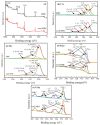Adsorption and Fenton-like Degradation of Ciprofloxacin Using Corncob Biochar-Based Magnetic Iron-Copper Bimetallic Nanomaterial in Aqueous Solutions
- PMID: 35214908
- PMCID: PMC8880508
- DOI: 10.3390/nano12040579
Adsorption and Fenton-like Degradation of Ciprofloxacin Using Corncob Biochar-Based Magnetic Iron-Copper Bimetallic Nanomaterial in Aqueous Solutions
Abstract
An economical corncob biochar-based magnetic iron-copper bimetallic nanomaterial (marked as MBC) was successfully synthesized and optimized through a co-precipitation and pyrolysis method. It was successfully used to activate H2O2 to remove ciprofloxacin (CIP) from aqueous solutions. This material had high catalytic activity and structural stability. Additionally, it had good magnetic properties, which can be easily separated from solutions. In MBC/H2O2, the removal efficiency of CIP was 93.6% within 360 min at optimal reaction conditions. The conversion of total organic carbon (TOC) reached 51.0% under the same situation. The desorption experiments concluded that adsorption and catalytic oxidation accounted for 34% and 66% on the removal efficiency of CIP, respectively. The influences of several reaction parameters were systematically evaluated on the catalytic activity of MBC. OH was proved to play a significant role in the removal of CIP through electron paramagnetic resonance (EPR) analysis and a free radical quenching experiment. Additionally, such outstanding removal efficiency can be attributed to the excellent electronic conductivity of MBC, as well as the redox cycle reaction between iron and copper ions, which achieved the continuous generation of hydroxyl radicals. Integrating HPLC-MS, ion chromatography and density functional theory (DFT) calculation results, and possible degradation of the pathways of the removal of CIP were also thoroughly discussed. These results provided a theoretical basis and technical support for the removal of CIP in water.
Keywords: AOPs; adsorption; advanced oxidation process; catalytic activity; ciprofloxacin; corncob biochar-based magnetic iron–copper bimetallic nanomaterial; fenton-like catalyst.
Conflict of interest statement
The authors declare no conflict of interest.
Figures













References
-
- Yu J., Tang L., Pang Y., Zeng G., Wang J., Deng Y., Liu Y., Feng H., Chen S., Ren X. Magnetic nitrogen-doped sludge-derived biochar catalysts for persulfate activation: Internal electron transfer mechanism. Chem. Eng. J. 2019;364:146–159. doi: 10.1016/j.cej.2019.01.163. - DOI
-
- Wang J., Tang L., Zeng G., Deng Y., Liu Y., Wang L., Zhou Y., Guo Z., Wang J., Zhang C. Atomic scale g-C3N4/Bi2WO6 2D/2D heterojunction with enhanced photocatalytic degradation of ibuprofen under visible light irradiation. Appl. Catal. B Environ. 2017;209:285–294. doi: 10.1016/j.apcatb.2017.03.019. - DOI
-
- Deng Y., Tang L., Zeng G., Zhu Z., Yan M., Zhou Y., Wang J., Liu Y., Wang J. Insight into highly efficient simultaneous photocatalytic removal of Cr(VI) and 2,4-diclorophenol under visible light irradiation by phosphorus doped porous ultrathin g-C3N4 nanosheets from aqueous media: Performance and reaction mechanism. Appl. Catal. B Environ. 2017;203:343–354. doi: 10.1016/j.apcatb.2016.10.046. - DOI
-
- Shah N.S., Ali Khan J., Sayed M., Ul Haq Khan Z., Sajid Ali H., Murtaza B., Khan H.M., Imran M., Muhammad N. Hydroxyl and sulfate radical mediated degradation of ciprofloxacin using nano zerovalent manganese catalyzed S2O82−. Chem. Eng. J. 2019;356:199–209. doi: 10.1016/j.cej.2018.09.009. - DOI
Grants and funding
LinkOut - more resources
Full Text Sources

